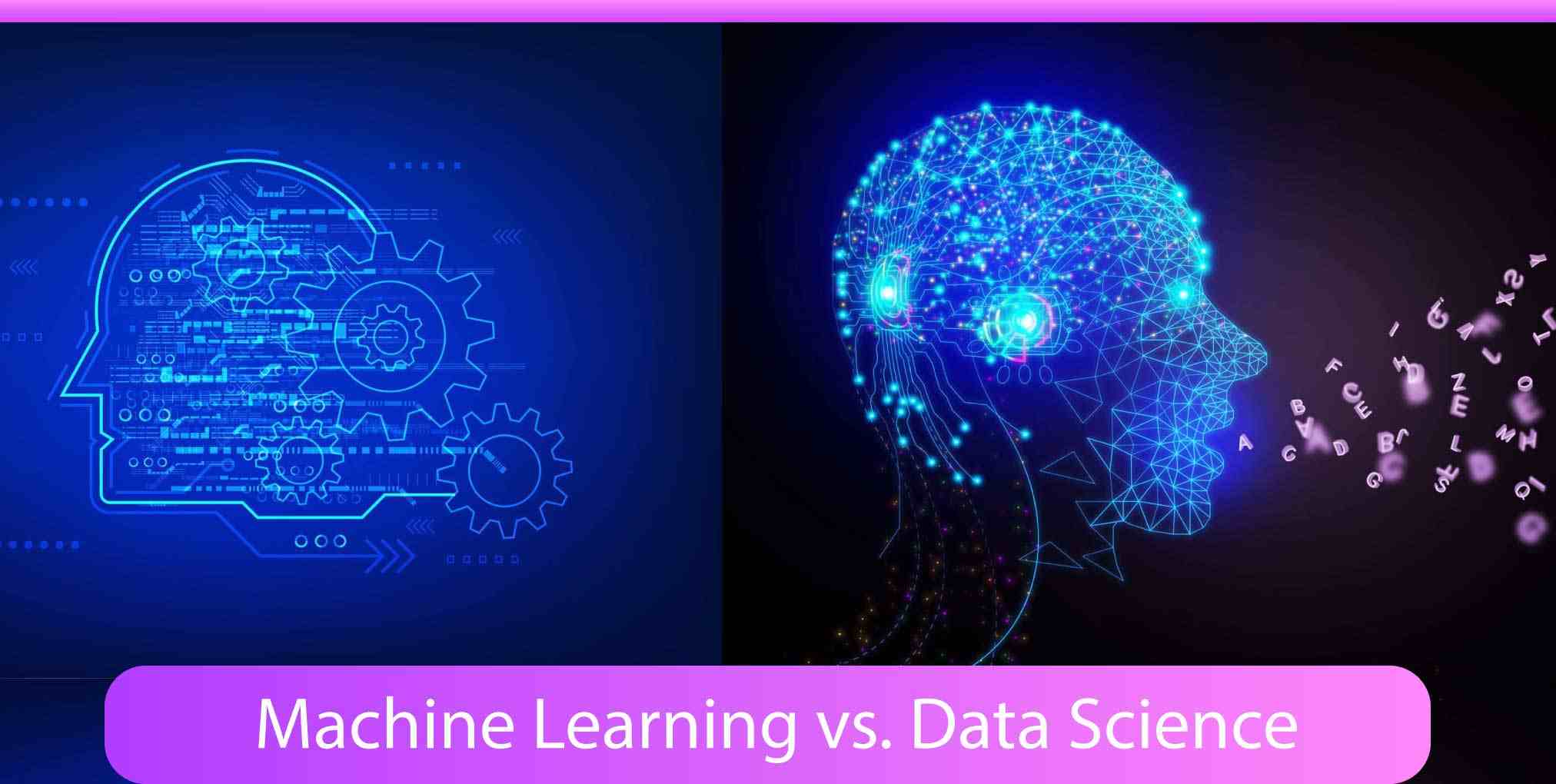

February 6, 2024
In the tech world, you often hear two important words: Machine Learning (ML) and Data Science. People often use these words like they mean the same thing, but some significant differences exist. This blog will help you understand these differences by exploring the top 10 key distinctions of machine learning vs data science. Let’s look closer at their unique roles and contributions in the always-changing world of technology.
Machine Learning and Data Science are closely related but have distinct focuses and applications.
Data Science is a wide-ranging area that uses machine learning tools to study and manage data. In addition to machine learning, it includes combining data, creating visuals, handling data, putting things into action, and making business choices.
Data Science uses math-based methods, systems, and processes to get helpful information from diverse data sources like the internet, written content, spoken words, and sensors. Many businesses find Data Science useful as it can cut expenses, boost earnings, make businesses more flexible, and enhance customer satisfaction.
What is machine learning? This is the most asked question in the tech field nowadays. At its core, machine learning is a type of artificial intelligence (AI) focused on creating machines that can learn. Machine learning importance is that instead of being specifically programmed, machine learning models carry out tasks by learning from data. It falls under the umbrella of AI and uses statistical methods to uncover insights from massive amounts of data.
These applications can learn and develop independently when exposed to new data. In simpler terms, machine learning applications learn from past experiences, use pattern recognition, and enhance their ability to produce knowledgeable and dependable results.

The increase in computer power and the drop in data storage costs have made data science a common practice in big companies. Data science and artificial intelligence are considered part of the 4th Industrial Revolution, bringing changes to traditional sectors like manufacturing, heavy industries, oil & gas, and energy. It’s also driving innovations in healthcare, retail, finance, insurance, and more.
Machine Learning is precious in automating tasks that involve well-defined input and output relationships. For instance, in scenarios where patterns or rules can define repetitive tasks, Machine Learning can be employed to automate the decision-making process. This has practical applications across various domains, including customer service, fraud detection, image recognition, and more.
The ability of Machine Learning models to continuously learn and adapt makes them versatile tools in optimizing processes and making predictions based on evolving datasets.
To start, the foundational elements of Data Science consist of:
These ultimately lead to valuable insights and the emergence of new business models.
On the other hand, machine learning is creating machines that can learn from data and make predictions. Machine learning components involve understanding the problem at hand, exploring and preparing the data, selecting an appropriate model, and training the system.
In machine learning, a problem is defined by input data (such as a specific image) and a label (indicating whether there is a cat in the image or not). The machine learning algorithm establishes a mathematical function to map from the input image to the label. The parameters of this prediction function are determined by minimizing the error between the function’s predictions and the actual data.
Machine learning, as the name implies, revolves around the development and application of algorithms. These algorithms enable systems to learn from data, recognize patterns, and make predictions or decisions without explicit programming.
Machine learning encompasses a variety of algorithms tailored for specific tasks. Some common types include:
Hierarchical structures that make decisions based on features of the input data.
Classifies data points by finding the optimal hyperplane that separates different classes.
Modeled after the human brain, neural networks consist of interconnected nodes that learn complex patterns.
Predict a continuous output based on input features.
Groups similar data points together without predefined categories.
Data science involves a broader set of methods, integrating statistical techniques, data mining, and machine learning as part of a multifaceted approach to extracting insights from data.
Statistical methods are fundamental to data science. Descriptive statistics provide summaries of the main aspects of a dataset, while inferential statistics draw conclusions and make predictions about a population based on a sample of data.
Data mining is discovering patterns and relationships in large datasets. It includes clustering, association rule mining, and anomaly detection techniques to uncover hidden patterns and knowledge.
Data scientists work closely with stakeholders to understand the business context and formulate questions that data analysis can address. This understanding is crucial for deriving actionable insights.
When it comes to machine learning and data science, a key difference is the hardware they need. We require systems that can handle lots of data and scale horizontally for business data science. Good RAM and SSD are necessary to avoid slowdowns. On the other hand, machine learning needs GPUs (Graphics Processing Units) for complex operations. There are also more advanced versions like Google’s TPUs that people use a lot.
The Data Science process involves three crucial stages: understanding the business, creating and testing model prototypes, and finally putting the model into production. Data engineers collaborate with data scientists to construct data pipelines, not just for developing models but also for testing them. In Data Science, businesses need to form diverse teams including data engineers, analysts, and scientists.
On the other hand, Machine Learning Services are a part of the data science process, focusing on solving a specific problem defined in clear terms. The machine learning model can identify the “correct” action by processing large volumes of data without explicitly coding the program. Machine learning engineers continuously assess and refine the model to improve its accuracy.

Machine learning heavily relies on programming to develop, implement, and evaluate algorithms. Proficiency in programming languages is crucial for designing, training, and deploying machine learning models.
Commonly used programming languages in machine learning include:
Python: Widely favored for its readability, extensive libraries (e.g., NumPy, pandas, scikit-learn), and community support.
R: Especially popular for statistical modeling and analysis.
Julia: Gaining traction for its high-performance capabilities in numerical and scientific computing.
Machine learning frameworks and libraries (e.g., TensorFlow, PyTorch) often require programming skills for model implementation, training, and optimization.
Understanding and implementing machine learning algorithms involve coding skills, whether creating decision trees, neural networks, or support vector machines.
Proficient programmers in machine learning are adept at debugging code and optimizing algorithms for efficiency and accuracy. Deploying machine learning models into production environments requires programming skills to integrate models seamlessly with existing systems.
Data science also requires programming skills, but the emphasis extends beyond just algorithm implementation. Data scientists use programming as a foundational skill for various tasks in the data analysis pipeline.
A significant portion of a data scientist’s work involves collecting, cleaning, and preparing data for analysis. Programming skills, often in languages like Python or R, are crucial for data wrangling and transformation tasks.
Data scientists use programming to perform statistical analysis, hypothesis testing, and other methods to derive insights from data. Programming skills are essential for creating visualizations that effectively communicate complex data patterns. Tools like Matplotlib, Seaborn (in Python) or ggplot2 (in R) are commonly used for data visualization.
Programming skills enable data scientists to collaborate effectively with other team members, including data engineers, business analysts, and domain experts.

Machine Learning primarily addresses prediction or classification problems by applying trained models. In this context, the goal is to develop algorithms and models to learn patterns and relationships from historical data. Once trained, these models can make predictions or classify new data based on the identified patterns.
For example, a machine learning model could predict the likelihood of a customer purchasing a product or classifying an email as spam or not. The emphasis is on automating decision-making processes based on patterns discerned from data.
Data Science, on the other hand, has a broader spectrum of problem-solving. It involves tackling various business challenges by extracting meaningful insights from data. These challenges may span a wide range, including optimizing operations, understanding customer behavior, improving marketing strategies, or enhancing product recommendations.
Data Science employs statistical analysis, machine learning, and other techniques to uncover patterns, trends, and correlations within data. Unlike Machine Learning, Data Science may not always involve building predictive models; instead, it often focuses on gaining a comprehensive understanding of the data to inform strategic decision-making.
In Machine Learning, a feedback loop is a crucial aspect of the model improvement process. Once a machine learning model is deployed and starts making predictions or classifications, it continuously receives feedback in the form of new data and real-world outcomes. This feedback is used to evaluate the model’s performance and accuracy.
This adjustment process involves updating the model based on the newly acquired data. The machine learning model is trained with this fresh data to adapt to evolving patterns and trends. This iterative cycle of receiving new data, evaluating performance, and updating the model is the feedback loop in machine learning.
In Data Science, the feedback loop involves refining analyses and insights rather than updating a predictive model. Data Science involves a variety of techniques, including statistical analysis, exploratory data analysis, and machine learning. The feedback loop in data science revolves around adjusting the analytical approach based on new data or changes in business requirements.
For example, if a data scientist has analyzed customer behavior and new data becomes available, the findings will be refined or updated to incorporate the latest information.
In Data Science, visualization is crucial, with BI analysts utilizing tools like Tableau, Qlik, and Looker to interpret and present results. On the other hand, in machine learning, visualization is employed to convey insights derived from training data. For example, when dealing with a multi-class classification problem, the confusion matrix is visualized to identify false negatives and positives.
In the context of Machine Learning, the assumption is often made that the input data is preprocessed and ready for training models. Machine Learning models rely on data to learn patterns, make predictions, or classify new instances. The input data is expected to be well-organized, with features appropriately formatted and devoid of inconsistencies or errors. While machine learning algorithms are powerful in discerning patterns, they are more effective when provided with clean and well-structured data.
The emphasis in machine learning is typically on the algorithmic aspects of training models. The assumption is that the data provided is in a format suitable for direct application in the learning process.
Data scinece has a broader range of analytical techniques, requiring thorough data preparation for various methods, including predictive modeling. In Data Science, data cleaning, transformation, and preparation are essential steps before diving into the analysis. This involves addressing missing or inconsistent values, handling outliers, and transforming variables to ensure the data is suitable for the analytical methods being employed. The goal is to ensure the data is accurate, relevant, and aligned with the specific objectives of the analysis.
After reading this blog you now have a clear idea of what is data science vs machine learning. Machine Learning and Data Science, even though connected, have different jobs in the tech world. Data Science sets things up by gathering, cleaning, and studying data. On the other hand, Machine Learning is the star in making models that predict things. It’s important for professionals and companies wanting to use data smartly to know the differences between machine learning vs data science.
For AI-powered solutions, whether it’s Machine Learning services or Big Data integration, Xeven Solutions is here for you. We specialize in providing advanced AI solutions that use cutting-edge technologies to meet your business needs. From predictive analytics to data-driven insights, Xeven Solutions delivers custom AI-powered solutions to drive innovation and efficiency in your operations.